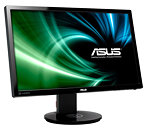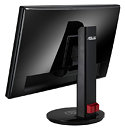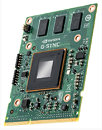Saturday, October 19th 2013

ASUS Announces Adoption of NVIDIA G-SYNC Technology
ASUS is excited to announce that it will adopt NVIDIA G-SYNC technology into its next generation monitor lineup. NVIDIA G-SYNC, a significant innovation in display technology, provides an excellent gaming experience and stunning visual quality by synchronizing the monitor's refresh rate to the GPU's render rate. Images are displayed the moment they are rendered, which results in smoother gameplay and sharper images through the elimination of onscreen tearing, stuttering, and latency.
G-SYNC technology includes an NVIDIA G-SYNC module that requires integration into monitors, as well as hardware and software incorporated into its Kepler-based GPUs. It removes the need to use older technologies such as V-Sync, which can eliminate tearing but can increase latency and stuttering during gameplay. G-SYNC eliminates this trade-off leading to an uncompromised PC gaming experience.ASUS, in a joint effort with NVIDIA, has been working over the past year to bring G-SYNC technology to market and will incorporate it into new monitors beginning in 2014. ASUS plans to release a G-SYNC-enhanced VG248QE gaming monitor in the first half of 2014 with pricing set at $399 USD in North America.
"ASUS strives to provide the best possible gaming experience by being at the forefront of technology and innovation. We are excited to be first to support and embrace NVIDIA's new G-SYSNC technology in upcoming ASUS gaming monitors. Gamers are certain to be impressed with its incredible step-up in smoothness and visual quality." said Vincent Chou, Associate Vice President of Display Business Unit ASUSTek.
G-SYNC technology includes an NVIDIA G-SYNC module that requires integration into monitors, as well as hardware and software incorporated into its Kepler-based GPUs. It removes the need to use older technologies such as V-Sync, which can eliminate tearing but can increase latency and stuttering during gameplay. G-SYNC eliminates this trade-off leading to an uncompromised PC gaming experience.ASUS, in a joint effort with NVIDIA, has been working over the past year to bring G-SYNC technology to market and will incorporate it into new monitors beginning in 2014. ASUS plans to release a G-SYNC-enhanced VG248QE gaming monitor in the first half of 2014 with pricing set at $399 USD in North America.
"ASUS strives to provide the best possible gaming experience by being at the forefront of technology and innovation. We are excited to be first to support and embrace NVIDIA's new G-SYSNC technology in upcoming ASUS gaming monitors. Gamers are certain to be impressed with its incredible step-up in smoothness and visual quality." said Vincent Chou, Associate Vice President of Display Business Unit ASUSTek.



66 Comments on ASUS Announces Adoption of NVIDIA G-SYNC Technology
Nvidia G-Sync HomepageNot all Kepler cards are supported either so make sure you have a supported GPU first.
so Yaa pay 400$ so 30fps can look smooth, or how about buy a 150$ dollar monitor and use the difference to buy a gpu that actualy is smooth over 60fps lol[/QUOTE]
No multi-screens solutions unless your willing to put up with the angle distortions.
I wish someone would make a global upgrade replacement for old V-Sync so everyone can use it with no dependencies. It can't be that hard, it's just that no one seems to even bother...
I also disagree with the multi-screen distortion issue. I use 3 TN panels in Surround and I have the side monitors slightly angled, which results in no color shifting. I switched from a single IPS monitor to 3 TN monitors, and I would never go back. The decreased response time and increased screen space sold me. I can get 3 good TN monitors for the same price as an excellent IPS monitor. I did my research before buying realizing that you need to be careful with TN panels, but if you buy a quality TN monitor and set it up correctly color shifting isn't a major issue since your viewing point is fixed (no one I know stands up and walks around when using a desktop computer).
Panel Technologies
TN Film, MVA, PVA and IPS Explained
PCMonitors - ASUS VG248QE
For the added +$150 dollars a better screen is definately an option unless you spend 100% of your time playing games. Wait those are call consoles aren't they ?
People tend to remember TN screens from their early days where image was pretty much gone at any angle other than 90° to the screen. Those days are long gone and most TN's hardly change any colors when viewed from an angle. And even if they do, differences are so small most won't even notice them unless if you're working professionally in which case you'll have IPS screen anyway...
i won't buy such product which limit my option to buy or upgrade another product. However, it would be a good choice if you are with the green team forever :slap:
I suppose someone will actually think there is value in this product :banghead:
Hardware is never gonna be about performance anymore if this keeps up, probably will end up as a tech-advertising hub for us to neglect.
I've thought of enough crap with Nvidia's buying/selling habits on popular technologies whenever they hesitate on a new card from AMD. The same for AMD as well. On upper hands they are like a couple of stupid kids that bother each other without a clue of what to pay attention to.
They no longer pay attention to us anymore, they just expect us to accept things like this and jack up the bundling deals and price cuts when we don't.
If it's any good, AMD will implement something similar.
But even then, what does that fix? If I get a better deal on the next-next generation of GPUs out of an nVidia card, I'm out of freaking luck, cause I don't have one of these "the way it's meant to be viewed" monitors, even tho I have pretty much have identical tech in my rig/monitor.
This is a fail/fail scenario for the end-user. Typical for nVidia.
Okay, here's another point, I'll seriously want to try something like this IF and only IF I hear about actual PRO gamers use it and find it helps with actual gaming, because as for immersion... stuff like the Occulus Rirft is the future, not this.
ACER has really poor viewing angles where Compaq hardly changes any color under angles. I don't think LED vs CCFL has anything to do with that as it depends on the liquid crystal part and not the illumination alone...